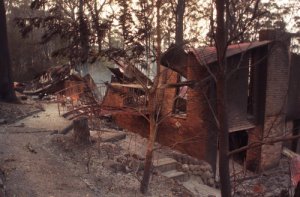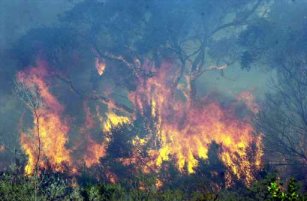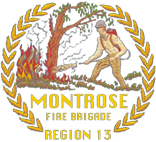Bushfire Safety
Recognise the risks - Plan To Survive!
Do you have a survival plan? Being prepared in case of bushfire means being self-reliant. In a major fire, CFA firefighters will not be able to protect every individual home. There is a great deal you can do to make your home a refuge. Avoid panic by being prepared. Bushfires are survivable if you are prepared and have an effective plan.

Develop Your Own Survival Plan
The risk of losing life and property during a bushfire is influenced by many things:
- the location and accessibility of your property
- the amount and type of surrounding vegetation
- the condition and placement of buildings
- the availability of water
- your physical capabilities and those of your family members
Everyone's situation is different. That is why each and every household needs to develop an individual survival plan.
What will the bushfire be like in my area? Where will it come from? Big fires usually come with strong, hot, northerly winds. A south westerly wind change - although cooler - can increase the danger because it will swing the fire in a different direction. This often catches people unaware and causes the most damage. As was the case in the Dandenong Fires in January 1997.
How intense will the fire be?
Vegetation is the fuel for a fire. The intensity of a fire refers to the amount of heat being generated. The higher the intensity the harder the fire is to control and the more damage it is likely to cause. It depends on weather, topography and vegetation.
Weather
High temperatures, high winds and low humidity add up to bushfire weather.
Topography
- Where is your house situated on your block?
- What is the slope of the ground?
- Which way does it face?
- Fires travel fastest uphill.
- Fires are more intense on northerly and westerly aspects because they are drier. The most volatile fuel is dry material thinner than an adult's little finger.

Vegetation
Vegetation is the fuel for a fire including long dry grass, leaf litter, bracken, scrub, shrubs and loose tree bark.
Surviving a Bushfire - Preparation
How can I make my house and property fire safe? Ways to make your house and property fire safe include the following:
- keeping grass cut, clearing away fallen leaves and dead undergrowth, tan bark and wood piles near your home;
- planting trees and shrubs away from your home;
- planting a protective shield of trees which don't burn easily around the house to slow the wind, cut down radiant heat and catch flying embers and sparks from a bushfire;
- cleaning leaves out of gutters;
- placing firescreens on windows to prevent the glass from cracking in radiant heat;
- placing weather stripping around the inside of doors and windows;
- making sure that you have access to adequate water supplies, such as: tanks, dams, swimming pools or water reserves;
- installing a sprinkler system around your home; and
- gathering appropriate fire safety equipment such as: ladders, hoses, buckets, mops, portable water pumps, a ladder, rake, a torch, and a knapsack spray to put out small "spot" fires.
Radiant Heat - The killer in a bushfire
Every summer, people try to survive bushfires by wearing light summer dresses, shorts, singlets, even swimsuits. They often die without the flames even touching their exposed skin. They don't understand the real risks of bushfire - heat stroke, dehydration even asphyxiation.
Radiant heat can kill. You need to cover up - dress to protect yourself - take refuge from direct heat.
What you can do to shield yourself from Radiant Heat: Cover up and Take Cover. Bushfires usually occur on days of high temperature. You and your family may be in shorts or swimsuits and bare feet or sandals.
So as soon as you know there are bushfires in your area. Cover Up!
Put on natural fibre long pants and light long-sleeved wool jumpers or close weave cotton shirts or overalls. Wear good solid footwear - preferably leather and a sturdy hat. This is your survival suit.
Plan to Survive - Bushfire: Leave or Stay?
- Things to consider: Does your family include young children, elderly people, or people with disabilities?
- If you plan to evacuate, will you go to a designated refuge area, a neighbours home, or a place well away from the threatened area?
- When will you go? The safest time to evacuate is before the fire starts, If you have decided
- How will you know if the roads are safe?
- What will you take with you?
- What will you do if you have planned to evacuate, but the fire is upon you before you can leave safely? Is your home able to provide safe shelter and withstand bushfire?
- Does everyone in your household know about the plan? Make time to sit down together to discuss it thoroughly.
Will I have time to evacuate safely?
Experience has shown that many residents receive little, if any, official warning of an approaching fire. Will you have time to leave the area safely or will you run the risk of being caught in your car or on foot in the open?
In a car you have much less protection from radiant heat than if you are in your house. The vast majority of deaths in bushfire involves people caught in cars or on foot. Once the fire is close, visibility will be very poor and travel will be hazardous.
If caught on the road
Remember, if your plan is to leave your home on a day of extreme fire danger then do it early - well before you become aware of a fire. A late evacuation is a deadly option. Declaration of a Total Fire Ban should be your trigger to put your plan into action.
- Always u-turn to safety if you have the option but if you are caught on the road you car offers the best protection from radiant heat as the fire front passes. Do not get out and run.
- Pull over to the side of the road into a clear area - dirt track or road is the best.
- Try not to park the car in a place where it is surrounded by fuel for the fire - long dry grass and scrub for example.
- Put the hazard lights and headlights on and keep the engine running.
- Cover exposed skin as much as possible with clothing - not synthetic.
- Ensure windows are up and vents closed.
- Get down low as possible below window level and cover up with a woollen blanket until the fire front passes. You will feel a reduction in the heat and then it is time to get out and move to safety. If travelling in the country, always carry a woollen blanket in you car for this purpose.
Bushfire Safety Programs
Fire Safety Garden
The Montrose Fire-Safety Garden displays ideas about how to create a garden that is safer in bushfire-prone areas.
Community Fireguard
CFA's Community Fireguard program is about small groups of residents who - with the help of a CFA facilitator - work together to deal with the bushfire threat.
Bushfire Blitz
Provides residents in areas of high risk from bushfire the opportunity to hear how they can plan for their safety in the event of a bushfire.
Home Fire Safety Programs
Home Fire Safety
Prevent and survive a housefire by knowing the danger areas within home.
Brigade in Schools
Provide school age children with fire safety information to help develop survival skills.
Smoke Alarm Replace Program
Smoke alarms save lives
Consideration should be given to:
- maintenance and testing
- location within the home

